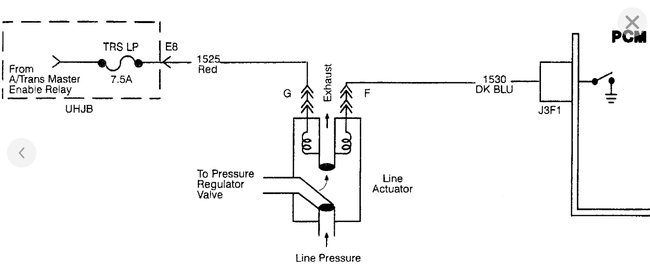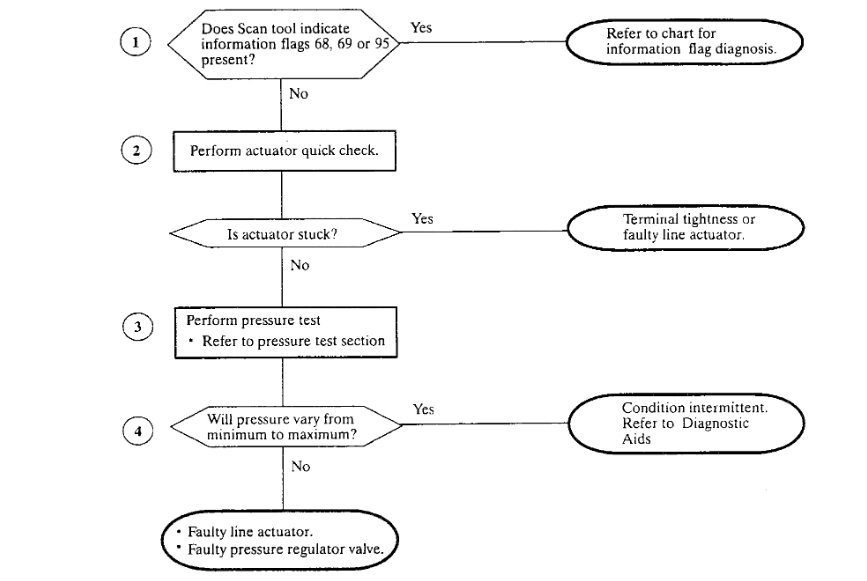Good morning,
You need a scan tool that can monitor transmission pressures. It is an OBD 1 system so the new scan tools will not work.
Code 13 is for the high pressure. The regulator is not regulating the pressure either from wiring, the regulator itself or the ECM.
Roy
13
LINE PRESSURE HIGH
During normal driving modes the PCM/TC adapts line pressure to prevent clutch slip and harsh shifts. This is accomplished by modulating the line pressure actuator ground (1530) to raise or lower pressure. Open circuit = high pressure, grounded circuit = low pressure. If the time required to make all shifts is too short and line pressure has been commanded low, it is determined that the actual line pressure is too high.
DTC/INFORMATION FLAG PARAMETERS
DTC/information flag 13 is set when the PCM has detected the following conditions for more than 5 shifts:
- Upshift pressure adaptive error is less than 112 which indicates over pressure. This condition must still exist after the up shift pressure adaptives have reached the lower limit (Low Limit = -288 kPa).
- Low load, low commanded pressure.
- Transaxle oil temperature above 40°C (104°F).
TEST DESCRIPTION
Numbered steps below refer to numbered steps on chart.
1. Check for information flags 68, 69, or 95. They must be eliminated first as a possible cause of a DTC/information flag 13.
2. Check actuator operation. Use actuator quick check. The actuator quick test will Pulse Width Modulate (PWM) the actuators at a set rate. Listen and compare noise of the line pressure actuator to that of other actuators. The noise of all should be similar.
3. Check pressure regulator valve operation. Use pressure test. Make sure pressure increases in correct increments during pressure test. If pressure changes erratically or moves in large increments, the pressure regulator valve is probably sticking.
4. If little or no pressure change, the regulator valve is stuck. To verify, test for minimum and maximum oil pressure per oil pressure test.
DIAGNOSTIC AIDS
- When the PCM detects a fault in the circuit (open, ground, short) the PCM will open the circuit internally to protect the circuit.
- Could be a hot or cold only condition. If condition is intermittent, try to reproduce DTC by checking malfunction (MALF) history table with Scan tool to see at what temperature the DTC will set and reproduce conditions.
- This DTC may set or intermittent harsh upshifts may be caused by a poor electrical connection at either the PCM, actuator connector plate, or Underhood Junction Block (UHJB) terminals. Wiggling connectors while performing an actuator quick test may isolate the problem area.
69
The line actuator is energized (low line pressure) when Circuit 1530 is grounded at PCM terminal J3F1. When the PCM grounds the circuit the voltage is monitored to check for proper circuit conditions.
INFORMATION FLAG PARAMETERS
Info. Flag 69 is set when the PCM has detected the following conditions after the line actuator circuit has been switched on electrically at the PCM twice per ignition cycle.
Voltage from the actuator to PCM terminal J3F1 (Circuit 1530) is greater than 2 - 2.5 volts.
Low resistance actuator or 12 volts shorted to Circuit 1530.
TEST DESCRIPTION
Numbered steps below refer to numbered steps on chart.
1. This step verifies problem is still present.
2. If actuator is shorted internally and resistance is one ohm or less than the average resistance reading of the other actuators, the actuator or connector plate is shorted.
3. If Circuit 1530 is shorted to voltage Info. Flag 69 will set. This step checks Circuit 1530 for a short to voltage.
4. This step will indicate if the actuator or a connector plate is faulty.
DIAGNOSTIC AIDS
When attempting to diagnose an intermittent problem use the Scan tool * to review supplemental diagnostic information. The supplemental data can be used to duplicate a problem.
* Select MALF History from Scan tool TCM menu.
Check the tightness of the female terminal grip with a spare male terminal.
IMPORTANT: When the PCM detects a fault in the circuit (open, ground, short), the PCM will open the circuit internally to protect the circuit.
Images (Click to make bigger)
Sunday, December 30th, 2018 AT 8:56 AM

